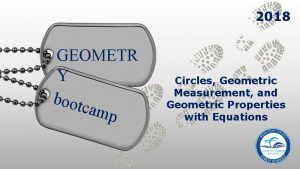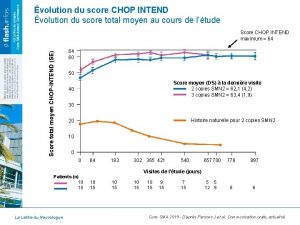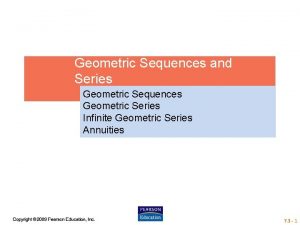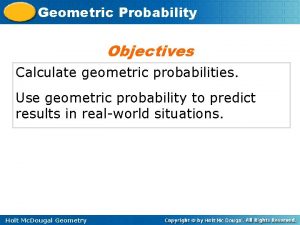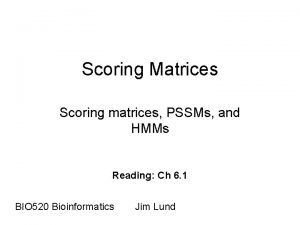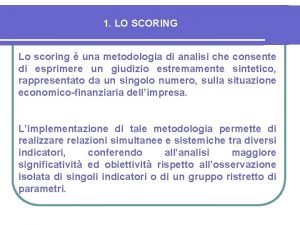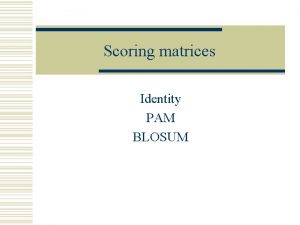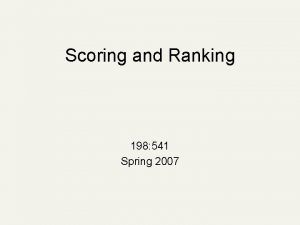Geometric scoring rules Egor Ianovski Aleksei Kondratev Alexander






























- Slides: 30

Geometric scoring rules Egor Ianovski, Aleksei Kondratev, Alexander Nesterov (Higher School of Economics – St. Petersburg) April 2021 1

Rank aggregation Suppose we have m candidates (alternatives, athletes) n individual strict rankings (votes, race protocols) R 1, R 2, . . . , Rn R 1 Amy Cas Bob R 2 Amy Cas Bob R 3 Bob Cas Amy R 4 Bob Amy Cas R 5 Cas Amy Bob The problem is how to find an aggregate weak ranking (ties or indifferences are allowed) 2

Applications • Sports competitions • Elections • Meta-search engines • Group recommender systems • Genetics and computational biology 3

Plurality Use points 1, 0, …, 0 R 1 Amy Cas Bob R 2 Amy Cas Bob R 3 Bob Cas Amy R 4 Bob Amy Cas R 5 Cas Amy Bob Points 1 0 0 Score(Amy)=1+1+0+0+0=2 Score(Bob)=0+0+1+1+0=2 Score(Cas)=0+0+1=1 Aggregate ranking: Amy ~ Bob > Cas 4

Generalised plurality 1) Use points 1, 0, …, 0 (plurality) 2) For equal aggregate ranks use points 1, 1, 0, …, 0 3) Still, equal aggregate ranks? Use points 1, 1, 1, …, 0, and so on, up to 1, …, 1, 0 R 1 Amy Cas Bob R 2 Amy Cas Bob R 3 Bob Cas Amy R 4 Bob Amy Cas R 5 Cas Amy Bob Pts 1 1 0 0 Pts 2 1 1 0 Aggregate ranking: Amy > Bob > Cas 5

Antiplurality Use points 1, …, 1, 0 R 1 Amy Cas Bob R 2 Amy Cas Bob R 3 Bob Cas Amy R 4 Bob Amy Cas R 5 Cas Amy Bob Points 1 1 0 Score(Amy)=1+1+0+1+1=4 Score(Bob)=0+0+1+1+0=2 Score(Cas)=1+1+1+0+1=4 Aggregate ranking: Amy ~ Cas > Bob 6

Generalised antiplurality 1) Use points 1, …, 1, 0 (antiplurality) 2) For equal aggregate ranks use points 1, …, 1, 0, 0 3) Still, equal aggregate ranks? Use points 1, …, 1, 0, 0, 0, and so on, up to 1, 0, …, 0 R 1 Amy Cas Bob R 2 Amy Cas Bob R 3 Bob Cas Amy R 4 Bob Amy Cas R 5 Cas Amy Bob Pts 1 1 1 0 Pts 2 1 0 0 Aggregate ranking: Amy > Cas > Bob 7

Borda Use points m-1, m-2, …, 1, 0 R 1 Amy Cas Bob R 2 Amy Cas Bob R 3 Bob Cas Amy R 4 Bob Amy Cas R 5 Cas Amy Bob Points 2 1 0 Score(Amy)=2+2+0+1+1=6 Score(Bob)=0+0+2+2+0=4 Score(Cas)=1+1+1+0+2=5 Aggregate ranking: Amy > Cas > Bob 8

Scoring rules A scoring rule is a family of non-increasing vectors for each m: – s 1, s 2, …, sm-1, sm for m candidates – t 1, t 2, …, tm-1 for m-1 candidates, and so on • Borda: – 1, 0 – 2, 1, 0 – m-1, m-2, …, 1, 0 • Plurality: – 1, 0, …, 0 • Antiplurality: – 1, …, 1, 0 for 2 candidates for 3 candidates for m candidates 9

Advantages of scoring rules Simple and clear Smith (1973), Young (1975) Only generalized scoring rules satisfy: Anonymity Neutrality Electoral consistency Apesteguia, Ballester, Ferrer (2011), Boutilier et al (2012, 2015) Maximize utility Main problem How should we choose a concrete vector of points? 10

Formula One Australian Grand Prix 2003 Rank Driver Constructor Laps Time/Retired Points 1 David Coulthard Mc. Laren-Mercedes 58 1: 34: 42. 124 10 2 Juan Pablo Montoya Williams-BMW 58 +8. 675 8 3 Kimi Räikkönen Mc. Laren-Mercedes 58 +9. 192 6 4 Michael Schumacher Ferrari 58 +9. 482 5 5 Jarno Trulli Renault 58 +38. 801 4 6 Heinz-Harald Frentzen Sauber-Petronas 58 +43. 928 3 7 Fernando Alonso Renault 58 +45. 074 2 8 Ralf Schumacher Williams-BMW 58 +45. 745 1 9 Jacques Villeneuve BAR-Honda 58 +1: 05. 536 0 10 Jenson Button BAR-Honda 58 +1: 05. 974 0 11 Jos Verstappen Minardi-Cosworth 57 +1 Lap 0 12 Giancarlo Fisichella Jordan-Ford 52 Gearbox 0 13 Antônio Pizzonia Jaguar-Cosworth 52 Suspension 0 Ret Olivier Panis Toyota 31 Fuel pressure 0 Ret Nick Heidfeld Sauber-Petronas 20 Suspension/Brakes 0 Ret Justin Wilson Minardi-Cosworth 16 Radiator 0 Ret Mark Webber Jaguar-Cosworth 15 Suspension 0 Ret Cristiano da Matta Toyota 7 Spin 0 Ret Ralph Firman Jordan-Ford 6 Accident 0 Ret Rubens Barrichello Ferrari 5 Accident 0 11

Formula One scoring rules Seasons 1 st 2 nd 3 rd 4 th 5 th 6 th 7 th 8 th Present - 2010 25 18 15 12 10 8 6 4 2009 – 2003 10 8 6 5 4 3 2 1 2002 – 1991 10 6 4 3 2 1 1990 – 1961 9 6 4 3 2 1 1960 8 6 4 3 2 1 1959 – 1950 8 6 4 3 2 9 th 10 th 2 1 How should we choose a vector of points? 12

Formula One -- 2003 Top drivers Rank 1 2 3 4 5 6 7 8 Points 10 8 6 5 4 3 2 1 DriverRace R 1 R 2 R 3 R 4 R 5 R 6 R 7 R 8 R 9 R 10 R 11 R 12 R 13 R 14 R 15 R 16 SCORE Schumacher 5 3 10 10 10 6 10 4 6 5 2 1 10 10 1 93 Räikkönen 6 10 8 8 Montoya 8 2 5 8 8 3 5 6 8 5 8 8 91 10 6 8 8 8 10 6 8 3 82 13

A helpful disadvantage RankVotes Gold Silver Bronze Rank Gold Silver Bronze 2 3 4 2 Amy Bob Cas Amy Amy Bob Cas 5 4 2 4 4 3 2 3 6 Amy wins under any points vector s 1, s 2, s 3. Suppose 5 years later Cas was disqualified for doping. RankVotes 2 3 Gold Amy Silver Bob Bob wins under any points vector t 1, t 2. 4 Bob Amy 2 Bob Amy 14

Arrow’s theorem Theorem (Arrow, 1950, 1963): For 3 or more alternatives, a rank aggregation rule satisfies: weak unanimity, independence of irrelevant alternatives, if and only if it is a Dictatorial rule Remark: Using this theorem, one can prove that the paradox from the previous slide is inevitable. 15

Biathlon 2014/15: Women’s Pursuit Rank 1 2 3 4 5 6 7 8 9 10 11 12 13. . . 40 Points 60 54 48 43 40 38 36 34 32 31 30 29 28. . . 29 1 348 March 2019: Glazyrina disqualified due to doping, results annulled Domracheva gets 348 points and 1 st place (tie-breaker) 16

Impossibilities • Independence of irrelevant alternatives requires dictatorship (Arrow, 1950, 1963) • Independence of winners/losers requires Kemeny-Young method (Kemeny, 1959; Young, 1988) • Scoring rules fail independence of winners/losers: – Profile R=(R 1, R 2, …, Rn), scores S=(s 1, s 2, …, sm), T=(t 1, t 2, …, tm-1) – For each scores S, T there is profile R such that removing one athlete inverts the final ranking (Fishburn, 1980) 17

Relaxing independence • Independence of unanimous losers (IUL): deleting loser-in-each-race does not affect outcome • Independence of unanimous winners (IUW): deleting winner-in-each-race does not affect outcome Rank 1 2 3 4 5 6 7 8 9 10 11 12 13. . . 40 Points 60 54 48 43 40 38 36 34 32 31 30 29 28. . . 1 18

Linear equivalence Suppose we have Borda’s rule: – 3, 2, 1, 0 (for m=4 candidates) Multiply e. g. by 3: – 9, 6, 3, 0 (for m=4 candidates) – Does it change aggregate ranking? – No! Add e. g. -2: – 7, 4, 1, -2 (for m=4 candidates) – Does it change aggregate ranking? – No! Scoring vectors Sm and Tm are equivalent if for a>0: Sm = a × T m + b 19

Which scoring rules satisfy IUL, IUW? Consider scores Sm and Tm-1: – s 1, s 2, …, sm-1, sm (for m candidates) – t 1, t 2, …, tm-1 (for m-1 candidates) Lemma (Kondratev, Ianovski, Nesterov, 2019): scores Sm and Tm-1 satisfy independence of unanimous losers <=> t 1, t 2, …, tm-1 and s 1, s 2, …, sm-1 are linearly equivalent unanimous winners <=> t 1, t 2, …, tm-1 and s 2, s 3, …, sm are linearly equivalent 20

Geometric scoring rules Theorem (Kondratev, Ianovski, Nesterov, 2019): a scoring rule satisfies IUL and IUW if and only if there is p>0 such that S = pm-1, pm-2, . . . , 1, p>1 m-1, m-2, . . . , 0, p=1 1 -pm-1, 1 -pm-2, . . . , 0, p<1 (S = 1+p+p 2+…+pm-2, …, 1+p+p 2, 1+p, 1, 0) 21

How should we choose points? – Choose p. FIA Formula One and geometric scoring rules 100 Present 90 2003 --2009 80 1991 --2002 70 1961 --1990 1960 60 1950 --1959 50 Geometric, p=1. 42 40 Geometric, p=1. 66 30 Geometric, p=1. 25 20 10 0 1 st 2 nd 3 rd 4 th 5 th 6 th 7 th 8 th 9 th 10 th 22

Extreme cases Geometric scores 1+p+p 2+…+pm-2, …, 1+p+p 2, 1+p, 1, 0 What do we have when the number of voters is fixed but p infinity? – Generalized plurality! (lexicographical voting rule, medal count ranking). Bernie Ecclestone, the chief executive of the Formula One Group, in 2009 proposed to use medal count. P 0? – Generalized antiplurality! Group recommender systems use it (Masthoff, 2015): e. g. , POLYLENS (movies) and REMPAD (multimedia to use in group reminiscence therapy). 23

Motorcycle GP 125 cc – 1999 Rank 6 7 8 9 10 11 12 13 14 15 Points 25 20 16 13 11 10 9 8 7 6 Driver Alzamora Melandri Azuma 1 2 3 4 5 5 4 3 2 1 R 2 R 3 R 4 R 5 R 6 R 7 R 8 R 9 R 10 R 11 R 12 R 13 R 14 R 15 R 16 SCORE 20 16 16 16 10 20 13 16 20 10 13 20 1 10 20 16 8 11 25 25 25 13 9 25 25 10 4 6 PARADOX OF WINNING A RACE 16 20 227 25 16 20 25 226 11 2 10 190 24

Paradox of winning a race In 2009, Bernie Ecclestone, the former chief executive of the Formula One Group, was outspoken about similar issues in Formula One – “It’s just not on that someone can win the world championship without winning a race. ” Instead of the scores then used, Ecclestone proposed a medal system which is equivalent to generalised plurality Fact (Kondratev, Ianovski, Nesterov, 2019): A geometric scoring rule is invulnerable to the winning a race paradox if and only if it is generalised plurality. 25

Majority winner is a candidate that finishes first in more than half of individual races. Theorem (Lepelley, 1992; Sanver, 2002): A scoring rule always ranks a majority winner first in the aggregate ranking if and only if it is plurality. Theorem (Kondratev, Ianovski, Nesterov, 2019): A generalized scoring rule satisfies independence of unanimous winners and always ranks a majority winner first in the aggregate ranking if and only if it is generalized plurality. 26

Majority loser is a candidate that finishes last in more than half of individual races. Theorem (Kondratev, Ianovski, Nesterov, 2019): A generalized scoring rule satisfies independence of unanimous losers and always ranks a majority loser last in the aggregate ranking if and only if it is generalized antiplurality. 27

Reversal symmetry R 1 Amy Bob Cas R 2 Amy Cas Bob R 3 Amy Cas Bob R 4 Bob Cas Amy R 5 Bob Cas Amy R 6 Cas Bob Amy R 1 Cas Bob Amy R 2 Bob Cas Amy R 3 Bob Cas Amy R 4 Amy Cas Bob R 5 Amy Cas Bob R 6 Amy Bob Cas Plurality fails reversal symmetry: Amy wins in a profile and its reversal. 28

Reversal symmetry: a candidate cannot be first in the aggregate ranking for a profile and for the reversal profile (Saari, 1994). Theorem (Kondratev, Ianovski, Nesterov, 2019): A scoring rule satisfies independence of unanimous losers and reversal symmetry if and only if it is Borda. A scoring rule satisfies independence of unanimous winners and reversal symmetry if and only if it is Borda. 29

Conclusions • Independence of unanimous winners and losers gives one-parameter geometric family that includes: – convex rules (good for competitions) – concave rules (good for group recommendations) – popular rules: Borda, plurality, antiplurality • Only 1 degree of freedom (instead of m-2) • The first characterization of a family (using natural and desirable axioms) • Elegant characterizations of Borda, generalized plurality and generalised antiplurality • What is next? – We revise our manuscript, developing an optimization approach and its empirical evaluation for how to choose the parameter p. 30
 Aleksei gaidajenko
Aleksei gaidajenko Aleksei dmitriev
Aleksei dmitriev Egor signienko
Egor signienko Egor signienko
Egor signienko Pasiūlei
Pasiūlei Natsbol
Natsbol Egor sidorov
Egor sidorov Script scoring action words
Script scoring action words Circles geometric measurement and geometric properties
Circles geometric measurement and geometric properties Tennis scoring system
Tennis scoring system Players in volleyball team
Players in volleyball team Truth tree logic
Truth tree logic Kelvin rodolfo
Kelvin rodolfo Woodcock-johnson iv scoring chart
Woodcock-johnson iv scoring chart Wechsler memory scale score interpretation
Wechsler memory scale score interpretation Eat, sleep, console scoring sheet
Eat, sleep, console scoring sheet Wida screener rubric
Wida screener rubric Ap biology exam 2021
Ap biology exam 2021 Moteur scoring
Moteur scoring Uil science practice tests
Uil science practice tests Tscc screening form
Tscc screening form Senior apperception test in psychology ppt
Senior apperception test in psychology ppt Eesa vb mapp
Eesa vb mapp Test of written language
Test of written language Comprehensive yet concise
Comprehensive yet concise Tabe test scoring chart
Tabe test scoring chart Revised flacc scale age range
Revised flacc scale age range Aldrete scoring
Aldrete scoring Pals-prek
Pals-prek Tabe test scoring chart
Tabe test scoring chart Tabe test scoring chart
Tabe test scoring chart








